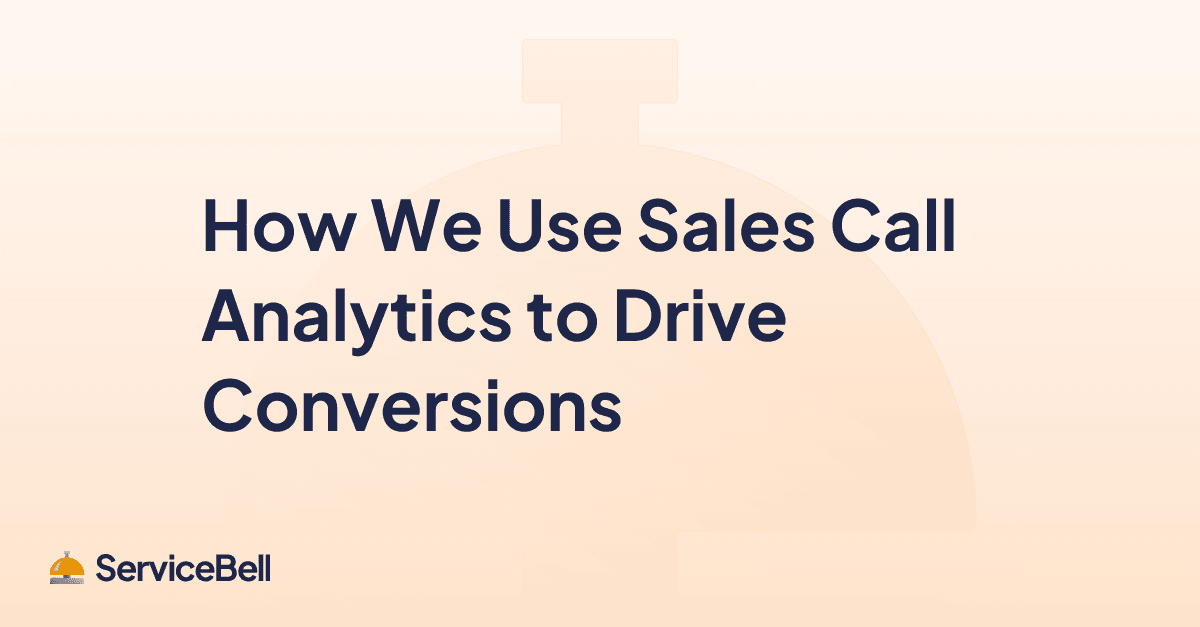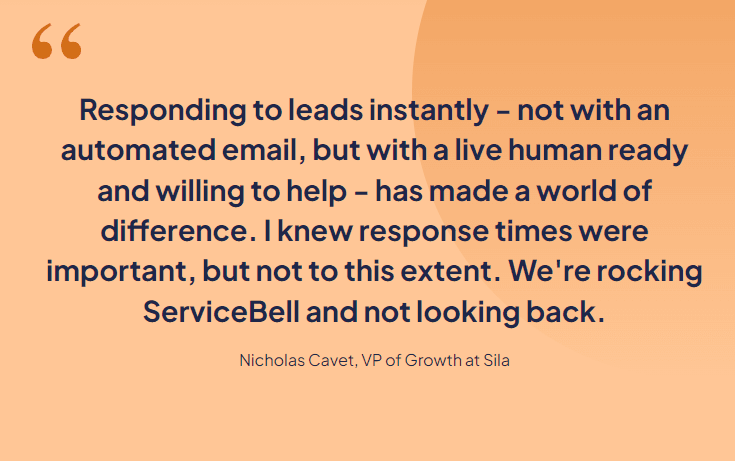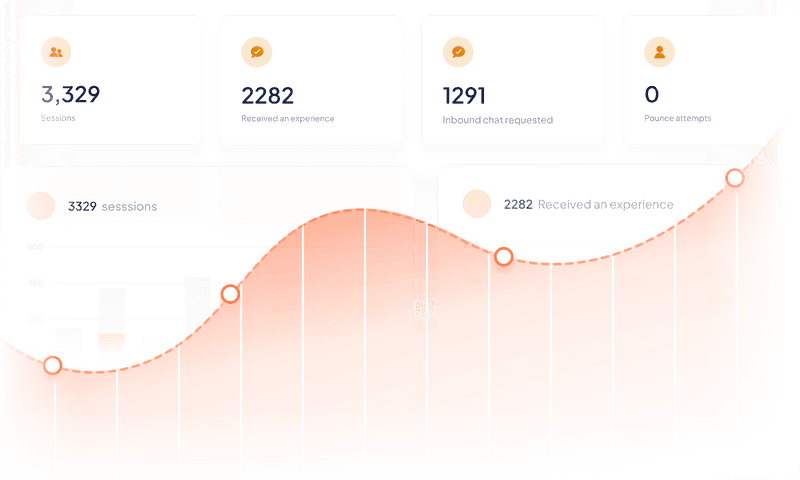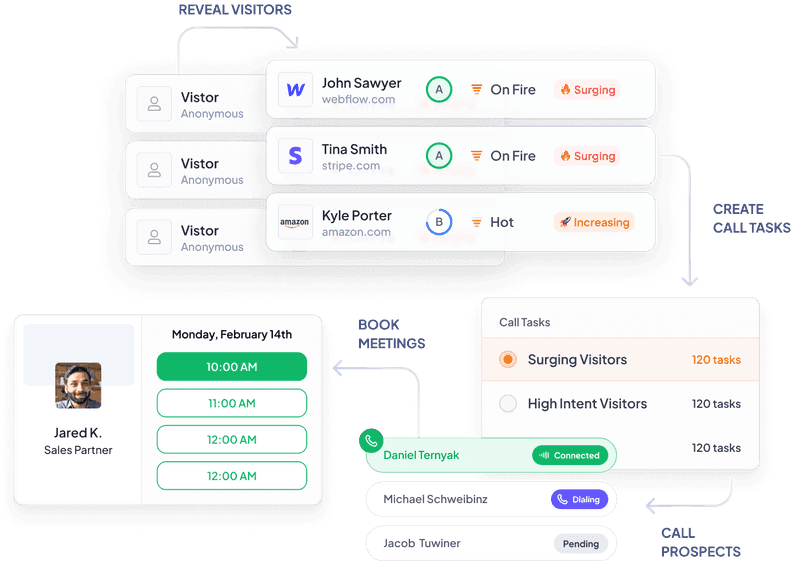Jul 5, 2024
How We Use Sales Call Analytics to Drive Conversions
Want to discover the best ways to use sales call analytics for business growth? Learn how we leverage data insights to improve our team’s call performance and drive conversions.

Helpful Summary
Overview: We highlight how sales call analytics can provide valuable insights to improve the sales call process and boost conversion rates.
Why Trust Us: At ServiceBell, we have a track record of optimizing cold-calling processes, improving lead response times, enhancing call quality, and boosting sales through our tool’s robust analytics.
Why It Matters: Sales call analytics helps optimize call performance, improve customer service, and make data-driven decisions. These benefits ultimately increase conversions.
Action Points: We suggest using ServiceBell’s Outbound Dialer to identify quality leads, boost customer engagement, and improve conversions.
Further Research: Check out the ServiceBell blog for more insights and industry news.
Want to Learn How to Use Sales Call Analytics to Boost Conversions?
Every call counts. Yes, even the ones that don't lead to sales. If well analyzed, they can eventually boost conversions. See why you can’t joke with sales call analytics? With analytics, businesses have a clearer perspective on how effective their sales calls are, and how to improve them.
If you’re yet to leverage this powerful tool, you’re slowing down your conversions. Sales call analytics give you in-depth insights that birth informed decision-making and sales growth.
It gets even better with the Outbound solution from ServiceBell. You can easily track these analytics with a few clicks, and save yourself tons of time and effort.
Ready to use call analytics to drive conversions? Let’s dive in.
But first…
Why Listen to Us?
We help numerous sales teams optimize their cold-calling processes and drive conversions through our allbound solutions which include insightful analytics. In Sila’s case, they added $1 million to their pipeline in four months of using ServiceBell.

The analytics solutions from our Outbound tools offer significant benefits. These include better customer insights, improved agent performance, and reduced call handling times. The result? More efficient operations, increased customer satisfaction and business growth.
What are Sales Call Analytics?
Simply put, sales call analytics are used to capture data from sales phone calls. They extract, collect, and analyze actionable insights from phone conversations by sales teams.
Data derived from these analytics is used to understand customers’ and prospects’ needs and behaviors. It is also used to gauge call agents’ performances. You can then use these insights to optimize the sales calling process, improve customer satisfaction, and ultimately increase your conversions.
How Do Sales Call Analytics Work?
So, here’s how it works.
A sales agent places a call to a customer or prospect and records the conversation manually, via a power dialer or using an AI dialer tool like ServiceBell’s AI Parallel Dialer. The conversation and the recipient’s details are then stored. Note that this must be done in compliance with data privacy regulations.

Next, the data is processed using analytic tools, and useful insights are extracted. These insights can include the sales rep’s performance, the recipient’s sentiments, and opportunities to upsell or cross-sell. The insights are then presented in a visual format like a dashboard, infographic, or report.
Why are Sales Call Analytics Important?
Sales call analytics is one of those tools we use and wonder how we managed before they came along. It’s so useful in knowing whether your sales calls are moving your business forward or backward. Here are reasons you must jump on the sales call analytics train if you’re not already on it.
Optimized Call Performance
The data and insights you gather from analyzing your sales calls are super helpful in boosting your sales call performance. You get to dive into key call indicators like call duration, call abandon rates, and call conversion rates. These insights really help you level up your call game.
Improved Customer Service
Sales call analytics enable you to understand your customers’ needs, challenges, and behaviors. For example, the analysis you get from call recordings allows you to note customers’ complaints and make the necessary adjustments. You also get insights into customers' preferences, which can be used to improve your offerings. When you address these issues, you can boost your customer satisfaction and service.
Data-Driven Decision Making
Running a business without data is like driving blindly. You take the wrong turns because you cannot see what’s happening around you. But data gathered from sales call analytics lets you see the real picture of your operations. You understand why you’re getting the results you have and make informed decisions based on the data you have derived.
Best Sales Call Analytics to Track
Not all data is useful and actionable. You need data that gives insights that improve your call performance and drive conversions. Here are the types of data you get from sales call analytics.
Call Duration
This is the length of time a sales rep spends on the phone with a customer. This data is important to gauge the level of customer satisfaction. For example, a call that was too long could mean the customer or prospect was bored and frustrated. A call too short could mean they were not properly engaged or their issues were not resolved.
Call Date and Time
The date and time of a call are necessary to know the peak call periods. This information shows when prospects are most responsive. Armed with this insight, you can schedule calls at the most appropriate times, leading to more time efficiency and better resource allocation.
Customer Details
Customer details such as name, phone number, and location are crucial as they assist in documentation and personalization. Firstly, knowing the customer's time zone helps you find the best time to call. Secondly, addressing the customer by their name can strengthen your relationship.
Keyword Frequency
Knowing the words and phrases your customers and prospects use gives an insight into their concerns. It helps you understand their needs and preferences. This understanding will, in turn, help you work on your sales strategies and improve your offerings.
Call Volume
This is the number of calls a sales rep has made. The data lets you see how productive each rep is and how to enhance their performance. With this data, you’re equipped to optimize your sales strategies and boost your overall team performance.
Response Rate
You’ll need to know the ratio of calls dialed to the ones picked. This data is crucial because it lets you see the effectiveness of your outreach efforts and sales process. Your eyes are open to areas that need improvement, leading to better call strategies.
Voicemail Rate
Data on the number of calls that went into voicemail is useful in driving conversions. For example, if the rate is high, you may need to assess your contact data quality and target accuracy. This could mean you’re targeting the wrong prospects. You may need to clean and update your contact list to improve your outreach efforts.
A high voicemail rate could also mean you’re not leveraging technology enough. For example, our AI Parallel Dialer will help you manage your voicemails. It lets you dial up to nine numbers at once and will help you detect if it’s a person or voicemail picking up the calls. Then you can then drop pre-recorded voicemails.

Call Abandon Rate
This is the percentage of inbound or outbound calls ended by the contact before a sales agent attends to them. A high abandon rate may mean the wait times are too long, the customer service is poor, or there are insufficient sales reps. To reduce this rate, look into your staffing arrangement, queue management, and call-back options.
Conversion Rate
To know how well your sales call strategies are working, you need data on conversion rate. This data shows the number of calls dialed against the number converted. It helps you evaluate the effectiveness of your sales efforts and indicates whether you need to restrategize.
Best Ways to Use Sales Call Analytics to Drive Conversions
How well are you using sales call analytics to boost conversions? Data will only work for you if you use the insights to make the right decisions. Here are the best ways to use sales call analytics to drive conversions.
Identify and Prioritize Quality Leads
This is one of the most useful ways to leverage sales call analytics. Use it to identify and analyze the characteristics of high-quality leads so you can prioritize them. This will ensure your sales reps spend their time and effort on prospects that are likely to convert.
ServiceBell helps you do this perfectly. Our Outbound Dialer lets you grow your pipeline with data-driven insights. With the robust analytics, tracking your call disposition is a breeze.

You’ll know the calls that resulted in sales, the ones that require a follow-up and those that entered voicemails. Your eyes are also open to the patterns and trends of your customers’ responses. This helps you identify and prioritize your leads.
Boost Customer Engagement
The data from sales call analytics enable you to understand your customers deeply. You have an insight into their behaviors, needs, challenges, and preferences. Armed with these insights, you can structure your conversations more effectively.
For example, if analytics show that a particular customer loves a feature, the rep can talk more about the feature during the next call. This will make the customer feel valued and keep them engaged for longer.
What about concerns and pain points? Data lets you note common concerns and objections of customers during calls and address them in subsequent calls. This results in better customer engagement and increased leads.
Refine Sales Call Techniques
Call analytics are very useful for improving sales call techniques. By thoroughly analyzing data from successful calls, you can identify the winning techniques and strategies. These techniques can be phrases, questions, or objection-handling tactics that work well for customers. You can now use the insights from this data to train your team for the best results.
Improve Follow-Up Strategies
Who calls once and gives up? Certainly not a proactive sales rep. Follow-up calls are essential to lead generation and conversions. However, without analytics, they could be ineffective. So, how do sales call analytics help to improve your follow-up calls?
First off, call analytics help you pinpoint the best times for follow-up calls. By keeping track of when you've had the most successful responses before, you'll know the times when prospects are most open to hearing from you. This boosts your odds of conversions.
Also, sales call analytics help you discover the follow-up script and techniques that yield the best results. By pinpointing the key tone, structure, and phrases that connect well with prospects, you can recreate them for better outcomes.
Measure Sales Agent Performance
Using the call volume metric, you can track the number of calls each sales rep made. This information lets you know their productivity level. Likewise, the call duration metric lets you know which reps spend adequate time engaging customers and prospects.
Analyzing each rep’s ratio of calls to conversions helps you identify reps performing well and those needing improvement. Identifying and rewarding high-performing agents will boost their morale and motivate others to improve their performance.
Train and Coach Your Sales Team
Sales call analytics lets you see the areas of strength and weakness of your sales reps so that you can organize tailored training programs. For example, insights can show a skills gap in areas like closing techniques or objection handling. When this happens, plan targeted coaching and training programs in those areas.
To help your reps improve their performance, you can have managers listen in during live calls to provide feedback. ServiceBell’s Virtual Salesfloor has got you covered here. This feature lets you go into a ‘Live Listen’ mode on the salesfloor while everyone learns as a team.

Optimize Sales Call Analytics With ServiceBell for Improved Conversion Rates
If you’re not leveraging sales call analytics for conversions, you’re leaving money on the table. When well applied, this data helps boost your sales call process, enhances customer service and fosters data-driven decision-making.
But first, you need to get the best sales call analytics from ServiceBell’s Outbound dialer. Our tool helps you track your outbound conversion rates, call dispositions and many more. These metrics are broken down by rep performance and list performance, helping you increase lead generation and sales.
What are you waiting for? Book a demo and start driving conversions.